How Syntropic Agriculture Restores Soil and Farms
 Print This Post
Print This Post
By Gabriella Soto-Velez, NCAT Sustainable Agriculture Specialist
There are many different terms for the practices that incorporate trees into agricultural production: agroforestry, intercropping, permaculture, food forests, and now there’s a new kid on the block: syntropic agriculture. Syntropic agriculture is gaining attention in the regenerative and sustainable agriculture space. But what exactly is it, and how does it differ from other agroforestry methods?
A Time-Tested Practice with Modern Applications
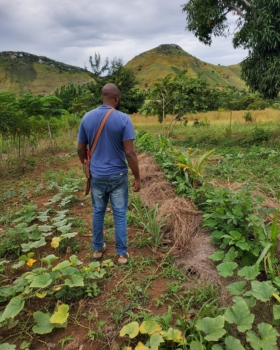
Syntropic agriculture system in Haiti. Photo credit: Roger Gietzen.
Like most agroforestry systems, people have been practicing syntropic agriculture for thousands of years. Indigenous communities across the Amazon, West Africa, and Southeast Asia have long used successional agroforestry techniques to cultivate staple crops while regenerating soil health and boosting biodiversity. The Mayan civilization, for example, practiced forest gardening with a mix of fruit trees, nitrogen-fixing plants, and staple crops—a method that closely resembles modern syntropic principles.
The modern adaptation of syntropic agriculture is credited to Swiss farmer Ernst Götsch, who began researching and refining these methodologies in Brazil. After working for a Swiss company specializing in genetically modified crops, he questioned conventional agricultural approaches, stating, “Wouldn’t we achieve greater results if we sought ways of cultivation that favor the development of plants, rather than creating genotypes that support the bad conditions we impose on them?”
The Core Principles of Syntropic Agriculture
Syntropic agriculture is based on multi-strata planting, mimicking natural forest succession to increase biodiversity and yields while reducing external inputs over time. The term syntropy refers to a force that creates diversity, order, and life—in contrast to agricultural practices that deplete soils and ecosystems.
What makes syntropic agriculture particularly exciting is its rapid establishment and adaptability. Unlike many agroforestry systems that take years to become productive, syntropic agriculture allows for harvests in as little as three months. It can also be applied across various climates, from tropical to temperate regions. While each location presents its own challenges and advantages, the core principles remain the same:
- High-density planting to maximize biodiversity and productivity.
- Regular pruning to manage plant succession and promote vigorous growth.
- ‘Chop and drop’ mulching, where pruned biomass becomes ground cover to build organic matter and protect the soil.
- Livestock integration, particularly with poultry and ruminants, to enhance nutrient cycling and manage undergrowth.
Livestock Integration: Optional but Highly Beneficial
Some consider livestock integration to be an optional principle in syntropic systems. Not all farms can or want to have livestock. But livestock integration can greatly enhance soil structure and soil fertility. One way people integrate livestock into syntropic systems in subtropical and tropical climates is by planting Napier and Mombasa grasses along field edges, providing valuable forage. Farmers can use a cut-and-carry method or employ solar-powered movable electric fencing to allow rotational grazing while protecting young trees and crops. Chickens can play a role in pest management while depositing nutrient-rich manure, further enhancing nutrient cycling.
Building Farm Resilience Through Syntropic Design
Like all agroforestry systems, syntropic agriculture offers multiple benefits, including greater farm resilience, improved soil health, and enhanced biodiversity. By continuously adding organic matter through mulching, these systems help prevent erosion, reduce runoff, and build soil organic matter, ultimately strengthening the soil microbiome. While initial inputs of mulch and manure are necessary to establish the system, once it reaches equilibrium, it requires little to no external inputs, making it a self-sustaining model for producing food, fuel, and fodder.
There is no one-size-fits-all approach to syntropic farming—each system is customized based on factors like climate, topography, sunlight, crop availability, and farmer needs. While implementing such a system may seem daunting, numerous online resources and in-person training opportunities are available to support farmers in the transition.
Get Started with Syntropic Agriculture
You don’t have to convert your entire farm at once—start small and experiment. Consider trying some of these practices on a small section of your land to get a feel for the system design, management, and benefits before expanding. This allows you to observe how syntropic agriculture works in your specific conditions and to make adjustments as needed.
For those eager to learn more, a Syntropic Agriculture Training will be held at ECHO Global Farms in Fort Myers, Florida, in July 2025. This training will cover the principles of syntropic farming, system design, implementation strategies, and hands-on techniques for managing agroforestry systems. To receive information about upcoming workshops like this, make sure you are subscribed to ATTRA’s Weekly Harvest e-newsletter.
If you’re considering implementing syntropic agriculture on your farm but aren’t sure where to start, reach out to NCAT’s agriculture specialists at askanag@ncat.org or call the ATTRA line at 1-800-346-9140. We can help you with system design, species selection, and management strategies, or point you toward additional resources. Take the first step toward a more regenerative and self-sustaining farm today!
ATTRA Resources
Other Resources
Syntropic Farming & Agroforestry | Yale Forum on Religion and Ecology
Agenda Gotsch – Ernst Götsch’s Syntropic Farming Official Website
Echo Global Farms TAD II Syntropic Agriculture Training
Roger Gietzen, Syntropic Ag Developer
Syntropic Farming & Agroforestry. Tara C. Trapani. Yale Forum on Religion and Ecology, January 25, 2024.




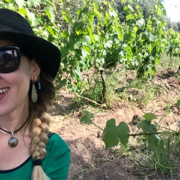
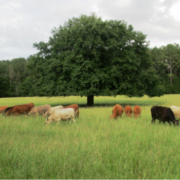
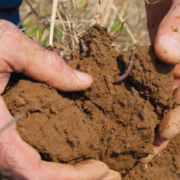


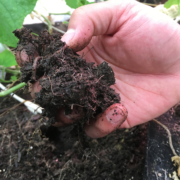

 USDA photo by Lance Cheung.
USDA photo by Lance Cheung.